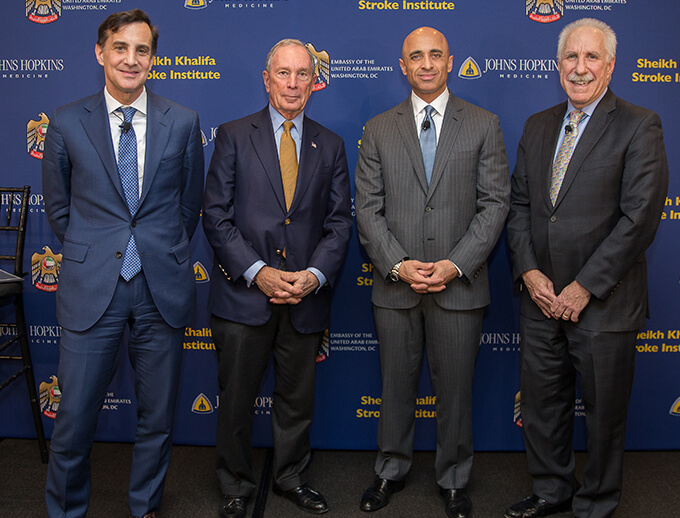Bridging Scientific Knowledge and New Treatments
 The institute was launched at a press conference on Feb. 1, 2018. (Image courtesy: Embassy of the United Arab Emirates in Washington, DC)
The institute was launched at a press conference on Feb. 1, 2018. (Image courtesy: Embassy of the United Arab Emirates in Washington, DC)The Impact of Stroke
About one-third of people who have strokes die each year, accounting for 5.5 million people worldwide, according to the World Health Organization. Of the survivors, two-thirds leave the hospital with a disability, as reported by the U.K. Stroke Association.
An estimated 25,000 men and women are diagnosed with stroke each year in the UAE, and 795,000 in the U.S. Risk factors for stroke are on the rise worldwide.
The economic cost — $72 billion in 2010 and projected to be $183 billion by 2030 — is profound, but the impact on human lives is incalculable: bereavement, disability and suffering.
Narrowing the time gap between scientific discovery and clinical treatment is a major goal of the Sheikh Khalifa Stroke Institute. Just as time is essential to interrupt the devastation of stroke and minimize lasting damage, speed is critical to evolving methods of stroke diagnosis, treatment, repair and rehabilitation.
Johns Hopkins: Leaders in Understanding the Complexity of Strokes
Johns Hopkins’ expertise in treating even the most challenging strokes is officially recognized. Two Johns Hopkins stroke centers are certified as Comprehensive Stroke Centers by the Joint Commission, a national symbol of quality reflecting a center’s commitment to meeting certain performance standards.
Preventing Stroke, One Patient at a Time
Preventing stroke starts with assessing each patient’s individual risk factors through personalized management. Johns Hopkins’ stroke care ensures that each patient benefits from a diverse team of practitioners, working together with the patient’s primary care provider to improve recovery outcomes and reduce the chances of another stroke.
Seeing Stroke More Clearly
Johns Hopkins researchers use brain imaging and functional assessments to track patients over the first year after a stroke. The data identify changes in blood flow in the brain, home in on parts of the brain that are active during certain tasks and observe how different parts of the brain work together during tasks such as naming and reading.
Changing How We Think About Stroke Recovery
Innovative teams at Johns Hopkins are charting new directions in poststroke therapy, with studies of how and why certain individuals recover (or do not), and how the brain can compensate through activating undamaged areas. Using video game technology and other approaches, Johns Hopkins experts are discovering the brain’s resilience and redefining what it means to recover from stroke.
FAST Response to Stroke Symptoms and tPA Saves a Life | Althea’s Story
When Althea’s arm started tingling and her speech became slurred, her son realized she was having a stroke. Thankfully, he got her to the hospital in time to receive a lifesaving medication. Now, she's contributing to research to help other stroke patients.

